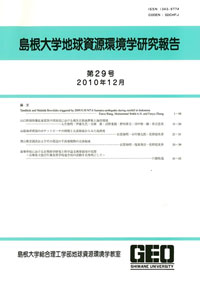島根大学総合理工学部地球資源環境学教室
ISSN:1343-9774

ダウンロード数 : ? 件
この文献の参照には次のURLをご利用ください : https://ir.lib.shimane-u.ac.jp/6437
島根大学地球資源環境学研究報告 25
2006-12-27 発行
Distribution of slope failures following the 1983 San'in Heavy Rainfall Disaster in Misumi-Kitsuka area, western Shimane, Southwest Japan
Pimiento Edgar
横田 修一郎
ファイル
内容記述(抄録等)
Small and shallow slope failures frequently occur in mountainous areas worldwide, due to intense rainfall. Regional hazard assessment on the occurrences of failures is thus an important subject, especially for developing countries. One method of assessing such hazard is based on statistical analysis of spatial distribution of past failures. As a case study for hazard assessment, we constructed detailed maps expressing the distribution of slope failures which occurred during the 1983 San'in heavy rainfall disaster in western Shimane, southwest Japan. Although similar maps have been already presented, they did not identify the source areas of failures alone, as they also included the deposit areas of slope failures and debris flows. For this study, we identified only the source areas of slope failures, using 1:8,000-scale aerial photographs that were taken just after the disaster. More than 2,300 failures were mapped in the study area. Based on the distribution of slope failures, we confirmed that they tend to appear in the steeper slopes. The average area of surface of rupture was about 1,400 m^2, and individual extent was greater in granitic rocks than in volcanic and schistose lithologies, as suggested by previous reports.
Other Article
PP. 49 - 59
